Melaleuca penicula is a plant in the myrtle family, Myrtaceae and is endemic to the south of Western Australia. It is a rare species only known from the Fitzgerald River National Park and resembles Melaleuca eximia with its spikes of red flowers but its leaves and stamen bundles are different.

Melaleuca eurystoma is a plant in the myrtle family, Myrtaceae and is endemic to the south of Western Australia. It is a small shrub with pale lemon to greenish flowers and egg-shaped to almost oval leaves.
Melaleuca eximia is a plant in the myrtle family, Myrtaceae and is endemic to the south of Western Australia. It is distinguished by its leaf arrangement, its large, showy red inflorescences and the large, furry bracts under the flowers.

Melaleuca halophila is a plant in the myrtle family, Myrtaceae and is endemic to the south of Western Australia. It is a prickly shrub, similar to Melaleuca thapsina but its flowers are white and the leaves are shorter and hairier.
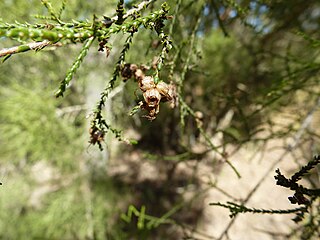
Melaleuca monantha is a plant in the myrtle family, Myrtaceae and is endemic to an area in Queensland, Australia. It is a shrub, similar to Melaleuca minutifolia with very small leaves but the leaves lack oil glands and its flowers occur singly, rather than in pairs. It is also similar to Melaleuca sylvana but is usually multi-stemmed and has a more dense crown than that species.

Melaleuca strobophylla is a shrub or small tree in the myrtle family Myrtaceae and is endemic to the south-west of Western Australia. It has papery bark, sharply pointed, twisted leaves and rather long spikes of creamy white flowers in summer.
Melaleuca adenostyla is a plant in the myrtle family, Myrtaceae and is endemic to the south-west of Western Australia. It is a large, broom-like shrub to about 5 metres (16 ft) high with narrow leaves and cream-coloured flowers and which often grows in saline places.

Melaleuca coccinea, commonly known as the goldfields bottlebrush is a shrub in the myrtle family Myrtaceae and is endemic the south of Western Australia. It is distinguished by its unusual foliage and bottlebrush spikes of red flowers.

Melaleuca calycina is a shrub in the myrtle family, Myrtaceae, and is endemic to the south-west of Western Australia. It is a stiff, erect shrub with oval to heart-shaped leaves, white flowers and star-shaped fruit.

Melaleuca cucullata is a large shrub in the myrtle family, Myrtaceae and is endemic to the south-west of Western Australia. Its species name alludes to the shape of the leaves which resemble miniature academics' hoods.
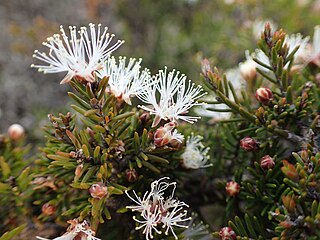
Melaleuca haplantha is a shrub in the myrtle family, Myrtaceae and is endemic to the south-west of Western Australia. It was first described as a new species in 1988 when Bryan Barlow undertook a review of Melaleuca cuticularis and found it to include 13 separate species.
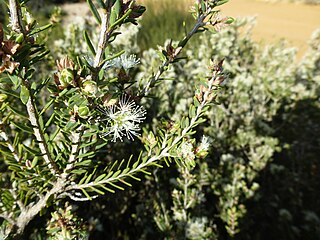
Melaleuca ordinifolia is a plant in the myrtle family, Myrtaceae, and is endemic to the south-west of Western Australia. It is closely related to Melaleuca brevifolia, but is smaller and differing mainly in its leaf features.
Melaleuca pritzelii is a plant in the myrtle family, Myrtaceae, and is endemic to the south-west of Western Australia. It was originally named in 1923 by Karel Domin as a subspecies Melaleuca densa var. pritzelii but raised to species status in 1992. It is a rare species, known only from a few plants in each of a small number of populations.
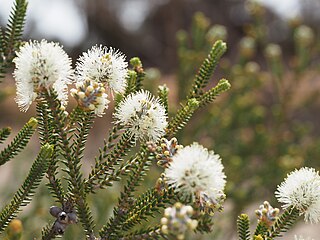
Melaleuca quadrifaria, commonly known as limestone honey-myrtle, is a plant in the myrtle family, Myrtaceae, and is native to the south of Western Australia. It is distinguished by the small size and arrangement of its leaves combined with its small spikes of white or cream flowers.
Melaleuca sciotostyla, commonly known as Wongan melaleuca, is a plant in the myrtle family, Myrtaceae, and is endemic to the south-west of Western Australia. It is an endangered species with only 476 mature plants known in 2001. It is closely related and very similar to Melaleuca haplantha but has narrower leaves and fewer stamens per flower than that species.
Melaleuca sculponeata is a plant in the myrtle family, Myrtaceae, and is endemic to the south-west of Western Australia. It is a small, rare shrub with fleshy leaves and white heads of flowers.

Melaleuca teuthidoides is a plant in the myrtle family, Myrtaceae and is endemic to the south of Western Australia. It is a shrub with rough bark and heads of white flowers on the ends of its branches in spring and early summer.
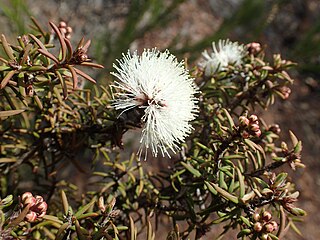
Melaleuca torquata is a plant in the myrtle family, Myrtaceae and is endemic to the south of Western Australia. It is a prickly shrub whose leaves have a distinct mid-vein on the lower surface and which has heads of pinkish white flowerheads in early spring.
Melaleuca fulgens subsp. fulgens, commonly known as the scarlet honey myrtle, is a plant in the myrtle family, Myrtaceae and is endemic to the south-west of Western Australia. In 1990, the species Melaleuca fulgens was separated into 3 subspecies and this is the most widespread of them. As with the other two subspecies, this one is notable for its showy flowers which are usually red but its foliage and fruits are also attractive features.
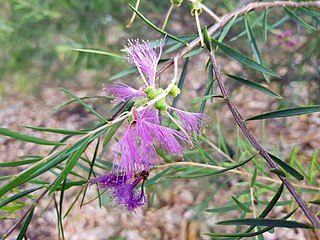
Melaleuca fulgens subsp. steedmanii, commonly known as the scarlet honey myrtle, is a plant in the myrtle family, Myrtaceae and is endemic to the south-west of Western Australia. In 1990, the species Melaleuca fulgens was separated into 3 subspecies. Of the two subspecies occurring in the south-west, this one has the narrower distribution, occurring mainly near Geraldton. As with the other subspecies, this one is notable for its showy flowers which are usually red but its foliage and fruits are also attractive features.












